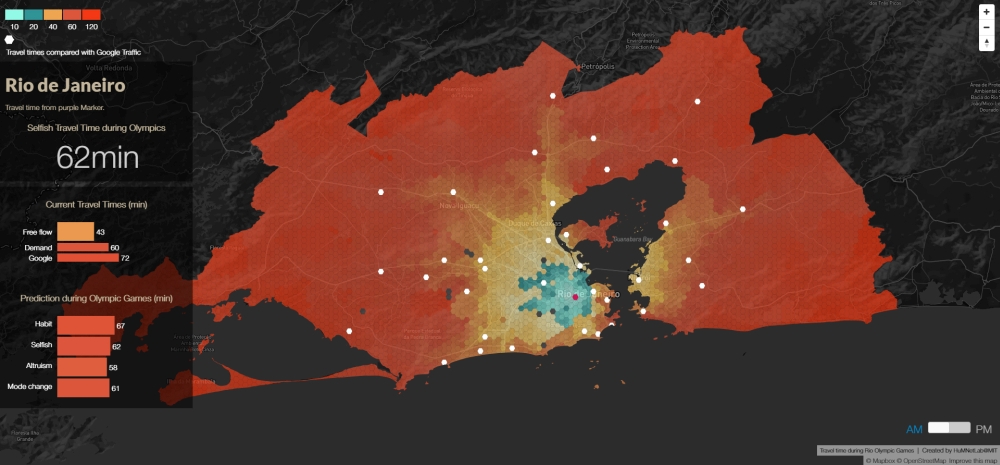Projects
In progress:
Reachability Index for Facility Spatial Distribution in cities
Understanding facility distribution in cities is of a paramount importance of civil planers and decision makers, as it relates to the design quality of cities and the well-being of citizens. Several studies have looked at the optimal spatial distribution of facilities and their scaling low function of population counts, however, very little is said about the actual reachability guaranteed by such optimal solutions. We propose to use the shortest travel time to the nearest facility as a proxy to score the reachability of facilities within a city. We collect data about different types of facilities from Foursquare and data about population counts from the gridded population dataset. We use OpenStreetMap to collect and build road networks.

Finished:
Travel demand management for collective benefits during mega events
Information technologies today can inform each of us about the route with the shortest time, but they do not contain incentives to manage travelers such that we all get collective benefits in travel times. To that end we need travel demand estimates and target strategies to reduce the traffic volume from the congested roads during peak hours in a feasible way. During large events the traffic inconveniences in large cities are unusually high, yet temporary, and the entire population may be more willing to adopt collective recommendations for collective benefits in traffic. In this paper, we integrate, for the first time, big data resources to estimate the impact of events on traffic and propose target strategies for collective good at the urban scale.

The travel time visualization plateform: http://www.flows-rio2016.com/
Yanyan Xu, and Marta C. Gonzalez, “Collective benefits in traffic during mega events via the use of information technologies,” J. Roy. Soc. Interface, 14(129), 2017. [pdf]
Clearer Skies in Beijing: High Density Spatio-temporal Data for Air Quality Assessment
Urban air pollution is one of the largest environmental health risks worldwide, and is expected to worsen over the coming decades as cities expand. Detailed, quantitative monitoring of urban air quality at high spatial and temporal resolution will be critical to assessing risks and mitigating impacts. Although most existing monitoring networks lack the requisite spatial and temporal resolution, sensitive and inexpensive new technologies now enable the deployment of distributed air quality (AQ) networks to capture the full range of pollutant variability in an urban area. However, no proven techniques for analyzing large AQ datasets for metrics of interest—pollution sources, distributions and exposures—are yet well established.
Yanyan Xu, Ruiqi Li, Shan Jiang, Jiang Zhang, and Marta C. Gonzalez, “Clearer skies in Beijing – revealing the impacts of traffic on the modeling of air quality,” Proc. of the 96rd Annual Meeting of the Transportation Research Board, Washington, D.C., 2017. [pdf]
Short-term traffic flow prediction
Current research on traffic flow prediction mainly concentrates on generating accurate prediction results based on intelligent or combined algorithms but ignores the interpretability of the prediction model. In practice, however, the interpretability of the model is equally important for traffic managers to realize which road segment in the road network will affect the future traffic state of the target segment in a specific time interval and when such an influence is expected to happen. In this paper, an interpretable and adaptable spatiotemporal Bayesian multivariate adaptive-regression splines (ST-BMARS) model is developed to predict short-term freeway traffic flow accurately.
Yanyan Xu, Qing-Jie Kong, Reinhard Klette, and Yuncai Liu, “Accurate and Interpretable Bayesian MARS for Traffic Flow Prediction,” IEEE Transactions on Intelligent Transportation Systems, vol. 15, no. 6, pp. 2457-2469, 2014. [pdf]